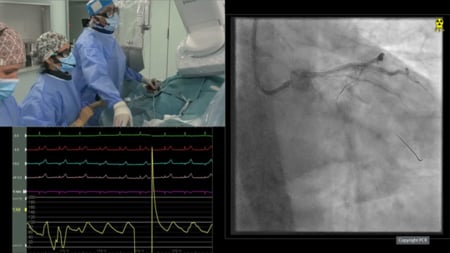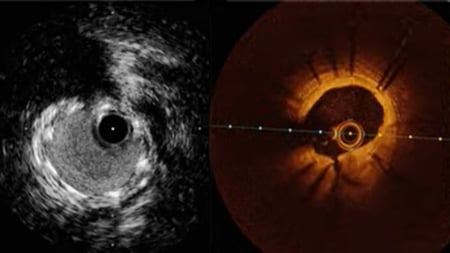Prasugrel-based de-escalation of dual antiplatelet therapy after percutaneous coronary intervention in patients with acute coronary syndrome
Selected in the Lancet by D. Giacoppo
References
Authors
Hyo-Soo Kim, Jeehoon Kang, Doyeon Hwang, Jung-Kyu Han, Han-Mo Yang, Hyun-Jae Kang, Bon-Kwon Koo, Jay Young Rhew, Kook-Jin Chun, Young-Hyo Lim, Jung Min Bong, Jang-Whan Bae, Bong Ki Lee, Kyung Woo Park, HOST-REDUCE-POLYTECH-ACS investigators
Reference
Lancet . 2020 Aug 28;S0140-6736(20)31791-8
Published
August 2020
Link
Read the abstractReviewer
My Comment
Why this study? – the rationale/objective
In patients undergoing percutaneous coronary intervention for acute coronary syndrome, a potent P2Y12 receptor inhibitor – ticagrelor or prasugrel – in association with aspirin up to 1 year is recommended as primary antithrombotic strategy. However, recent trials on different dual antiplatelet therapy durations have shown that by prolonging treatment an increasing occurrence of major bleeding can exceed potential benefits in terms of ischemic protection.
Considering that the risk of major cardiovascular events after percutaneous coronary intervention for acute coronary syndrome is more pronounced in the early phase, it might be hypothesized that dual antiplatelet therapy with potent P2Y12 receptor inhibitor de-escalation after a short postprocedureal period of conventional-dose treatment can achieve an optimal balance between ischaemia and bleeding.
How was it executed? – the methodology
The HOST-REDUCE-POLYTECH-ACS is a randomised, open-label, investigator-initiated, adjudicator-blinded, non-inferiority trial conducted at 35 centres in South Korea.
Briefly, immediately after initial coronary angiogram for acute coronary syndrome, patients who met the eligibility criteria for therapy with prasugrel (age < 75 years, body weight ≥ 60 kg, and no history of transient ischaemic attack or stroke) and had at least one significant lesion amenable to percutaneous coronary intervention with drug-eluting stent were randomly assigned by web-based system to prasugrel dose de-escalation (5 mg) or conventional-dose continuation (10 mg) after 1 month of dual antiplatelet therapy with 10 mg of prasugrel plus 100 mg daily of aspirin.
All patients received 300 mg of aspirin and 60 mg of prasugrel before percutaneous coronary intervention. All patients continued aspirin throughout the follow-up regardless of the strategy assigned and dual antiplatelet therapy was recommended for 1 year in both treatment groups.
The primary endpoint was a composite of net adverse clinical events including all-cause death, non-fatal myocardial infarction, stent thrombosis, stroke, clinically-driven repeat revascularization, or Bleeding Academic Research Consortium (BARC) ≥ 2 events at 1 year. The prespecified absolute non-inferiority margin was 2.5% (one-sided alpha=0.025, power=0.75). Key secondary outcomes were a composite of cardiovascular death, myocardial infarction, stent thrombosis, or ischemic stroke (efficacy endpoint) and BARC ≥ 2 events (safety endpoint).
A data safety and monitoring board overviewed the safety of the trial and all clinical events were adjudicated by an independent clinical events committee.
What is the main result?
From September 2014 to December 2018, a total of 2338 subjects were randomized to prasugrel de-escalation (n=1170) or standard-dose continuation (n=1168). Patients had mean age of approximately 60 years, were predominantly male (89.3%), exhibited significant proportions of diabetes (42.3%) and dyslipidaemia (76.9%), and were generally admitted for the first cardiac ischemic event (prior myocardial, 3.8%; prior revascularization, 11.2%).
Clinical presentation was primarily unstable angina (60.8%), followed by non-ST-elevation myocardial infarction (25.3%), and to a minor extent ST-elevation myocardial infarction (13.9%). Approximately half of the enrolled patients had multivessel disease and 28.7% received multivessel intervention. The culprit lesion was more frequently located in the left anterior descending (50.3%), a bifurcation was involved in 20.1% of lesions, and a thrombotic burden was detected in 13.3% of lesions. Durable- and bioresorbable-polymer drug-eluting stent distribution was balanced according to the randomization protocol (2 x 2 factorial design, ancillary independent study hypothesis of durable- vs. bioresorbable-polymer drug-eluting stent).
At 1 year, the primary endpoint occurred in 82 patients (7.2%) in the de-escalation group and 116 patients (10.1%) in the conventional group. The difference resulted not only in a non-inferiority of prasugrel dose de-escalation compared with conventional-dose therapy (pnon-inferiority<0.0001), but also in a significant risk reduction (hazard ratio 0.70, 95% confidence interval 0.52-0.92, p=0.012).
The key secondary efficacy endpoint occurred in 16 patients (1.4%) in the de-escalation group and 21 patients (1.8%) in the conventional dose group (HR 0.76, 95% CI 0.40-1.45, p=0.40). The significant difference in primary endpoint between groups was driven by the key secondary safety endpoint that occurred in 33 patients (2.9%) in the de-escalation group and 67 patients (5.9%) in the conventional dose group (HR 0.48, 95% CI 0.32-0.73, p=0.0007).
The bleeding reduction was essentially related to BARC 2 events (2.1% vs. 5.1%), while no significant difference between groups was observed when only BARC ≥3 events (i.e., major bleeding) were considered (0.8% vs. 0.7%; HR 1.12, 95% CI 0.43-2.90; p=0.82).
Per-protocol and subgroup analyses were consistent with primary results.
Critical reading and the relevance for clinical practice
The HOST-REDUCE-POLYTECH-ACS trial shows that in patients receiving drug-eluting stent for acute coronary syndrome, de-escalation of prasugrel dose from 10 to 5 mg after 1 month of standard-dose therapy significantly reduces the incidence of bleeding without unfavourable tradeoff in terms of antithrombotic efficacy compared with conventional-dose therapy.
The HOST-REDUCE-POLYTECH-ACS trial supports a novel, pragmatic antithrombotic strategy based on potent P2Y12 inhibitor dose de-escalation rather variations in antiplatelet therapy composition or duration. The design of this trial was centered on temporal changes of ischemic risk after percutaneous coronary intervention for acute coronary syndrome – higher immediately after acute presentation and stent implantation, decreasing across subsequent months – and the persistent occurrence of bleeding over time with prolonged dual antiplatelet therapy, especially when a potent P2Y12 inhibitor is used. Under similar assumptions, previous trials have shown favourable results by downgrading dual antiplatelet therapy from a potent P2Y12 inhibitor to clopidogrel.
The promising conclusions of the HOST-REDUCE-POLYTECH-ACS trial should be viewed in light of a number considerations.
First, recently several randomized trials comparing 1 or 3 months of dual antiplatelet therapy followed by P2Y12 inhibitor monotherapy vs. conventional 12-month dual antiplatelet therapy have shown quite comparable incidences of ischemic outcomes between antithrombotic regimens and a possible major bleeding reduction associated with short dual antiplatelet therapy.
The results of such trials employing short dual antiplatelet therapy followed by P2Y12 inhibitor monotherapy have not been validated against similarly short dual antiplatelet therapy followed by conventional aspirin monotherapy, thus it is unclear whether the benefits observed are associated to the limited duration of dual antiplatelet therapy or the composition of antithrombotic monotherapy.
In aggregate, the real advantage of dual antiplatelet therapy with early P2Y12 inhibitor dose de-escalation compared with short dual antiplatelet therapy followed by P2Y12 inhibitor or conventional aspirin monotherapy is uncertain and warrants further data.
Second, the benefit of a potent P2Y12 inhibitor dose de-escalation strategy essentially consists of a significant risk reduction in bleeding events. However, when the analysis was restricted only to major bleeding (BARC ≥ 3 type), incidences between groups became quite comparable, indicating that BARC 2 type events drove the only individual component of the primary endpoint showing a significant difference.
This finding might reduce the relevance of the results of the HOST-REDUCE-POLYTECH-ACS trial since the prognostic impact of BARC 2 type events has previously resulted to be low compared with more severe types of bleeding.
Third, although only patients with acute coronary syndrome were included, approximately half of them were admitted for unstable angina and low proportions exhibited ST-segment myocardial infarction and thrombotic lesions. In addition, most of patients had no prior cardiac ischemic event and complexity of coronary artery disease was low-to-moderate.
Further analysis is required to establish whether prasugrel de-escalation is safe also in high-risk patients.
Fourth, the primary endpoint of the HOST-REDUCE-POLYTECH-ACS trial was a composite of a large number of adverse cardiovascular events (all-cause death, non-fatal myocardial infarction, stent thrombosis, stroke, clinically-driven repeat revascularization, clinically-driven repeat revascularization, or BARC ≥2 type bleeding) with different individual prognostic impact and occurrence rate.
Moreover, sample size was estimated by using unconventional, non-conservative requirements of power (i.e., 75% instead of 80% or preferably 90%, as usually recommended for a non-inferiority design), though on the other hand more events than expected were observed.
These limitations indicate that, even though the results of the HOST-REDUCE-POLYTECH-ACS trial are clear and did not show inconsistency across sensitivity analyses, a non-inferiority design for few hard ischemic endpoint (e.g., composite of cardiovascular death or non-fatal myocardial infarction) would leverage the safety of potent P2Y12 inhibitor dose de-escalation.
Fifth, the trial was open-label.
Finally, the HOST-REDUCE-POLYTECH-ACS trial enrolled only east Asian patients, that according to previous reports have resulted to be more prone to bleeding and less prone to thrombosis. Whether trial results can be translated to the European population is still undefined.







No comments yet!